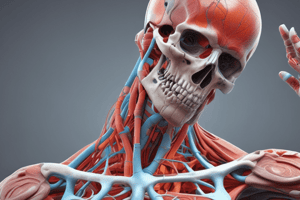Podcast
Questions and Answers
What does osteokinematics primarily describe?
What does osteokinematics primarily describe?
- The structure of the skeletal system.
- Muscle strength and endurance.
- Types of joint injuries.
- Movement of bones in three cardinal planes. (correct)
Which of the following best differentiates translatory motion from rotary motion?
Which of the following best differentiates translatory motion from rotary motion?
- Translatory motion refers to voluntary movements, while rotary motion refers to involuntary movements.
- Translatory motion is related to joint stability, while rotary motion is not.
- Translatory motion occurs around an axis, while rotary motion occurs in a straight line.
- Translatory motion is linear while rotary motion involves rotation around an axis. (correct)
Which axis of rotation is NOT mentioned in relation to osteokinematic motions?
Which axis of rotation is NOT mentioned in relation to osteokinematic motions?
- Anterior-posterior axis
- Medial-lateral axis
- Diagonal axis (correct)
- Vertical axis
In the anatomical position, which reference point is used for abduction and adduction of fingers?
In the anatomical position, which reference point is used for abduction and adduction of fingers?
What is TRUE about degrees of freedom as discussed in biomechanics?
What is TRUE about degrees of freedom as discussed in biomechanics?
What is the correct definition of horizontal abduction?
What is the correct definition of horizontal abduction?
Which term describes the rotation of the forearm that involves the ulna remaining stationary?
Which term describes the rotation of the forearm that involves the ulna remaining stationary?
Which movement is referred to as ulnar deviation?
Which movement is referred to as ulnar deviation?
What type of motion is most commonly described as circumduction?
What type of motion is most commonly described as circumduction?
In what plane does typical abduction occur?
In what plane does typical abduction occur?
What type of motion occurs around an axis of rotation?
What type of motion occurs around an axis of rotation?
What determines the velocity of points on an object in rotary motion?
What determines the velocity of points on an object in rotary motion?
How many degrees of freedom does the shoulder joint possess?
How many degrees of freedom does the shoulder joint possess?
Which type of movement does the elbow joint primarily allow for?
Which type of movement does the elbow joint primarily allow for?
What is goniometry used for in physical therapy?
What is goniometry used for in physical therapy?
In the opening of the mouth, which type of motion occurs first?
In the opening of the mouth, which type of motion occurs first?
What describes the maximum degrees of freedom for the human body?
What describes the maximum degrees of freedom for the human body?
How many degrees of freedom does the wrist joint have?
How many degrees of freedom does the wrist joint have?
Which of the following motions is an example of translatory motion?
Which of the following motions is an example of translatory motion?
Study Notes
Osteokinematics: Definitions and Clinical Applications
- Osteokinematics describes bone motion in the sagittal, frontal, and horizontal planes around corresponding axes (anterior-posterior, medial-lateral, vertical).
- Motions include abduction/adduction, flexion/extension, and rotation. Anatomic position is the reference point for motion descriptions unless otherwise specified.
- Finger abduction/adduction uses the middle finger as a reference; toe abduction/adduction uses the big toe.
- Horizontal abduction/adduction occurs in the transverse plane; wrist motion is described as ulnar/radial deviation; ankle motion is inversion/eversion.
- Pronation/supination involves radius rotation over the stationary ulna. Thumb motion is described as opposition and circumduction. Foot supination/pronation combines several osteokinematic motions.
- To analyze motion from Figure 1.4 (textbook): identify the plane of movement and the axis of rotation.
Types of Motion
- Translatory (linear) motion: All points on an object move the same distance in the same direction at the same velocity. Measurable in various units (mm, miles, etc.).
- Rotary motion: Motion around an axis of rotation in an arc; measured using goniometers (degrees). Points on the object move at different velocities depending on their distance from the axis.
- Curvilinear motion: Combination of rotary and translatory motion (e.g., sliding down a slide, opening the mouth). Resultant displacement differs from net distance.
Quantifying Osteokinematic Motion
- Goniometry: Uses a goniometer to measure active (muscle-initiated) and passive (external force-initiated) joint motion in degrees. Axis of the goniometer is placed over the joint.
- End-feel: Therapist assesses the resistance at the end of a joint's range of motion. Indicates normal joint structure and function or identifies pathologies.
Types of End-Feel
- Hard (bony): Bone-on-bone contact; e.g., elbow extension.
- Firm (capsular): Ligament or joint capsule resistance; e.g., wrist flexion.
- Soft: Soft tissue approximation (muscle); e.g., elbow flexion.
- Pathologic: Unexpected end-feel (e.g., bony end-feel during knee flexion) or empty end-feel (pain prevents full ROM), often indicating injury or inflammation.
Kinematic Chains
- The body functions as one kinematic chain; movement at one segment affects other segments.
- Open kinematic chain: Distal segment is free to move; e.g., kicking a ball.
- Closed kinematic chain: Distal segment is fixed; e.g., a squat.
Degrees of Freedom
- Defined as the number of planes in which a joint moves. The maximum degrees of freedom for the human body is three (sagittal, frontal, transverse).
- Examples: Glenohumeral (shoulder) joint has three degrees of freedom; elbow has two; wrist has two.
Evaluating Back Pain
- Assess the back and related segments: For low back pain, check hips and SI joints; possibly knees/ankles. For thoracic spine pain, examine the cervical spine, scapulothoracic joint, and shoulders.
Open vs. Closed Kinematic Chains
- Open kinematic chain: Distal segment (e.g., foot) is free to move; proximal segment is relatively fixed (e.g., knee flexion while seated).
- Closed kinematic chain: Distal segment is fixed (e.g., foot on the ground); proximal segment moves (e.g., squatting).
- Closed chain can be described as femoral-on-tibial (femur moving on fixed tibia) or tibial-on-femoral (tibia moving on fixed femur) motion.
Examples of Open and Closed Chains
- Open Chain Examples: Chest fly (elbows fixed, shoulders abduct); examples to consider: push-ups, heel raises, heel raises with weights.
- Closed Chain Examples: Squats (feet fixed); examples to consider: push-ups, heel raises, heel raises with weights.
Challenges of the Chain Analogy
- Original Definition: Dr. Arthur Steinler's 1955 definition (considerable external resistance) is subjective and varies by individual.
- Body Complexity: The body isn't a simple chain; multiple segments branch out, complicating the analysis. Example: A basketball player resting hands on knees (a mixed chain scenario).
- Changing Task Demands: Activities like walking involve both open and closed chain phases (stance phase: closed; swing phase: open.) Walking with a cane further complicates analysis; running has periods with both limbs on ground and both limbs in the air.
Advanced Examples
- Elbow step-ups: A complex gymnastic movement illustrating the changing nature of open and closed chains during a single exercise.
- 90-degree push-ups (plank push-ups): Another example with shifting open and closed chains phases.
Simplified Definitions for the Course
- Open kinematic chain: Distal segment free to move.
- Closed kinematic chain: Distal segment fixed to the earth or immovable object.
Studying That Suits You
Use AI to generate personalized quizzes and flashcards to suit your learning preferences.
Description
This quiz explores the concepts of osteokinematics, including the definitions and clinical applications of bone motion in different planes. It covers key motions like flexion/extension and abduction/adduction, as well as the specific reference points for various movements. Assess your understanding of these fundamental biomechanics principles.




